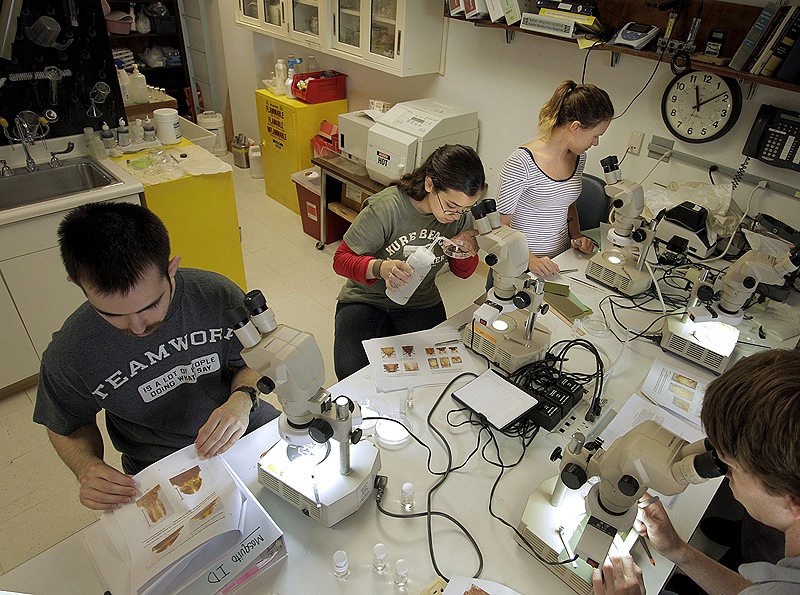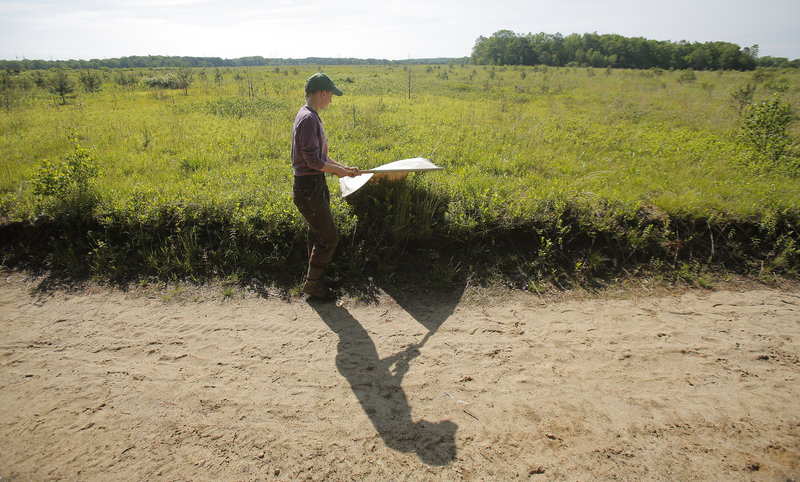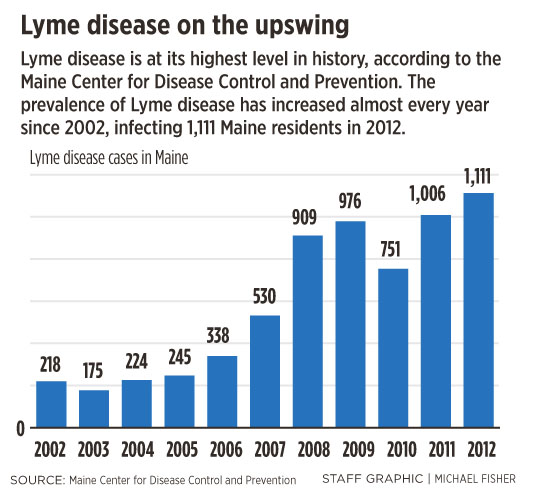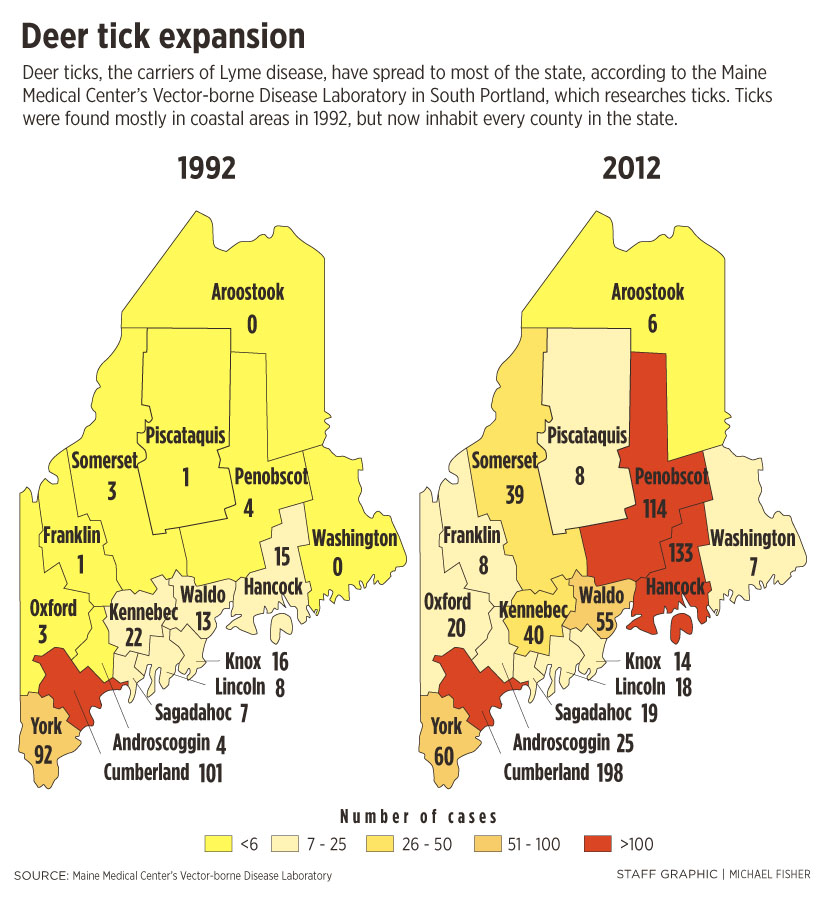Melanie Renell and Jackie Allen trudged through the scrub and thin pine forest, wearing shin-high boots and extra-long winter socks and waving blanket-sized flags made out of broomsticks and corduroy fabric.
In their backpacks, they carried tweezers and plastic vials filled with rubbing alcohol.
Enter the tick hunters.
On Thursday, the pair combed through the Kennebunk Plains, on a search-and-research mission for the bloodsucking parasites.
The two work for Maine Medical Center’s Vector-borne Disease Laboratory in South Portland, which studies the 14 species of ticks in Maine, including the deer tick, carrier of Lyme disease.
The lab, founded in 1988 and unique to Maine, conducts far-reaching research on ticks, and participates in national studies that could end up being vital to controlling ticks and improving public health.
The studies delve into topics such as how rats and migratory birds, in addition to deer, can contribute to the spread of Lyme disease.
Lyme disease reached its highest level in Maine in 2012, with 1,111 cases reported, according to the Maine Center for Disease Control and Prevention. That’s up from 218 reported cases in 2002, roughly a fivefold increase over a decade. Deer ticks, the carriers of Lyme disease, have spread inland from coastal regions and into the northern reaches of Maine.
Capturing the ticks is as simple as brushing the flags over foliage, and inspecting the fabric for the crawling insects. Corduroy is a useful fabric for the research because the ticks can easily latch onto the grooves. Once the ticks are on the fabric, the researchers grab them with tweezers and deposit them into the alcohol vials, where the ticks swim around for a while before dying.
“They’re hardy little creatures,” said Renell, wearing a green John Deere baseball cap.
On Thursday, they caught a few ticks, but it was far below the 100 ticks per hour level that Renell reached one time when tick hunting in Wells. Renell grinned while letting a tick crawl on her arm before squeezing it with a tweezer.
The tools for capturing ticks might be low-tech, but the research is complex. The two captured mostly deer ticks, but the purpose of Thursday’s field work was to pick up dog ticks for Northern Arizona University, which is comparing the genetics of ticks across different regions of the United States.
At the tick lab, researchers analyze many aspects of ticks, including possible effects of climate change, animals that carry ticks, changes in Maine’s habitat that have made it more hospitable for ticks, and ways to naturally control the tick population.
While all ticks are a nuisance to humans, deer ticks are a focus of the lab because carrying Lyme disease makes them a public health threat. Deer ticks need to be latched on for at least 36 hours to transmit Lyme disease.
June and July in Maine are high nymph deer tick season, which is when the adolescent ticks are numerous and it’s an especially ripe time for picking up a tick. The nymphs are difficult to spot, as they are only the size of a poppy seed. In many cases of Lyme disease, people did not know they had a tick, said Chuck Lubelczyk, field biologist for the tick lab.
Sheila Pinette, director of the Maine CDC, said that Lyme disease is a growing concern, and cases keep cropping up in new areas of the state. In the early 1990s, Lyme disease was limited to coastal areas. “It keeps going farther and farther into the state,” she said.
Some sufferers of Lyme disease have lasting symptoms, even after the disease has run its course. Patients with Post-treatment Lyme Disease Syndrome, as it’s called, suffer from fatigue, joint and muscle aches and pain, according to the U.S. Centers for Disease Control and Prevention.
There are multiple reasons for the deer tick’s expansion, researchers say.
Lubelczyk said Maine’s deer tick population has exploded in part because much of the state’s farmland has been converted to open space or forestland in recent decades. Invasive, non-native species, such as Japanese barberry and bittersweet vine, have spread into the converted farmland, providing prime habitat for deer ticks, he said.
With suburban sprawl, more people live in the tick’s habitat, Lubelczyk said. Increasing deer populations have also helped the deer tick population grow.
A thornier question is whether climate change has contributed to the spread of Lyme disease.
The answer is unclear, but Lubelczyk said snow acts as an insulator for the deer ticks, and the ticks won’t die off in the winter unless there’s a deep freeze for a few weeks without snow.
“I suspect that part of the reason the range of the deer tick population has expanded (in Maine) is because of moderating temperatures,” said Susan Elias, a researcher at the tick lab. “It hasn’t been proven.”
However, deer ticks die during extremely hot weather, which controls populations in the mid-Atlantic and Southern states, Elias said.
The tick lab also assists in researching natural products to combat ticks, so that property owners have an option other than pesticides. Rosemary wintergreen oil disrupts the nervous system in ticks, and is often available through pest control companies. Lubelczyk said a fungal spray that acts as a natural poison for ticks is also being developed.
People from all over the state send ticks to the lab for identification, either by mail or via the tick drop box. When the lab started counting the ticks it received — in 1989 through the early 1990s — the deer ticks were mostly from coastal areas in southern Maine. They have since spread to most of the state, and submissions are much more numerous.
The ticks go under a microscope for identification. On Wednesday, Lubelczyk was teaching volunteers and students how to tell the difference between the different varieties.
Dog ticks are pale gray, while deer ticks are darker. Dog ticks are also somewhat larger, the size of a grape when engorged with blood from feasting on the host.
Ticks can’t jump, so they don’t drop down on the heads of people taking walks in the forest. But Lubelczyk said it’s still possible for ticks to latch onto your head if it brushes against leaves where ticks are hiding, or if you’re rolling on the ground.
“Ticks are the consummate hitchhikers,” Lubelczyk said.
Joe Lawlor can be reached at 791-6376 or at:
jlawlor@mainetoday.com
Twitter: @joelawlorph
Send questions/comments to the editors.








Comments are no longer available on this story